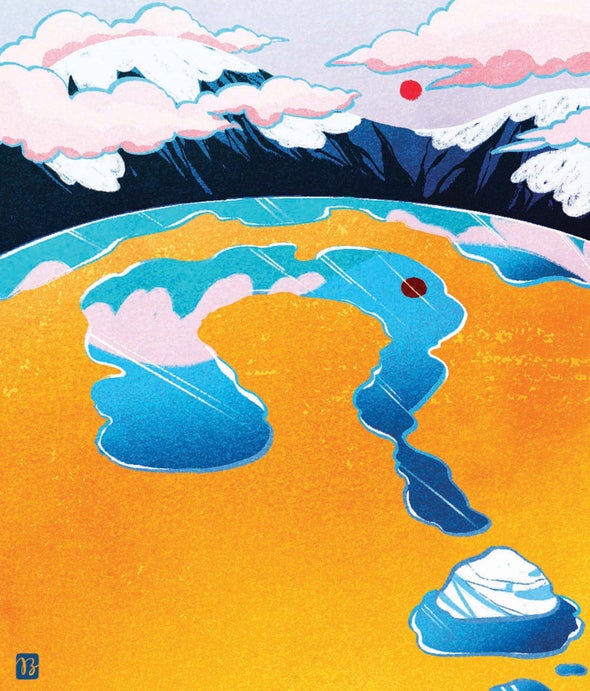
You might think these lakes would be expanding, not vanishing. As climate change warms the tundra—melting surface snow and ice and thawing the permafrost—there should be more surface water. Existing lakes should grow because of the extra water, and new ones might appear. Recently, however, scientists have observed not just shrinking lakes but lakes that have completely gone away. A paper published this year in Nature Climate Change, based on satellite imagery, found widespread lake loss across the Arctic over the past 20 years. Led by University of Florida postdoctoral researcher Elizabeth Webb, the scientific team found that lakes have shrunk or disappeared completely across 82 percent of the Arctic’s lake-rich regions.
Scientists have long recognized that global warming would thaw permafrost, and like many climate effects, that one appears to be happening faster than predicted. But the surprise is really about the bodies of water in the permafrost environment.
Many scientists shared the commonsense expectation that as permafrost thawed, lakes would at first expand because of increased meltwater flowing into them. Eventually, researchers projected, progressive warming during the 21st and 22nd centuries would dry out the Arctic enough that lakes would begin to shrink. But now it looks as if Arctic lakes are disappearing a century or more sooner than predicted.
There is a big difference between a lake gradually dwindling during a hotter climate and a lake vanishing from sight in less than a year. At the end of the summer of 2018, following the warmest and wettest winter on record at that time, 192 lakes in northwestern Alaska had completely or partly drained away. Some large lakes, believed to have existed for millennia, shrank drastically in what appears to have been a matter of months. Scientists have labeled this phenomenon “catastrophic lake drainage.”
What caused this? Basically, the ground is becoming more permeable. We talk about “solid ground,” but its particles of rock, mineral and organic matter actually have spaces between them. Outside the Arctic, those spaces are filled with air or water; surface water drains into them. (You see this after it rains, when after a few hours the puddles have disappeared.) Arctic landscapes are different. In permafrost, the pore spaces are filled with solid ice, so liquid water cannot readily penetrate. But when the permafrost thaws, water can flow downward. So these far northern lakes are disappearing because surface water can drain rapidly into the subsurface as the permafrost warms up.
Why did scientists miss this? One reason, offered by Webb and her colleagues, is that most climate models assume that permafrost thaw is driven only by warming air. New evidence suggests that rainfall—particularly increasing autumn rain—is now contributing substantially to permafrost loss. The rainfall carries heat into the ground. Yet none of the models in the large Coupled Model Intercomparison Projects (CMIPs) includes such processes. This is a good example of why—no matter how sophisticated our models are or may one day be—we need direct observation of the natural world.
Lakes make up as much as 40 percent of Arctic lowlands, where they provide crucial freshwater for Indigenous communities and critical habitat for a wide range of plant and animal life. The loss of marshy areas that accompany these lakes can also lead to an increase in wildfires, which, in a troubling feedback loop, melts more permafrost. This permafrost holds a huge amount of methane, a greenhouse gas that can create 80 times as much atmospheric warming as carbon dioxide in the short term. Rapid release of this methane could accelerate global warming dramatically.
There is, of course, a clear path to saving Arctic lakes: stop the carbon pollution that is driving global climate change.
This article was originally published with the title “The Puzzle of Vanishing Lakes” in Scientific American 327, 6, 76 (December 2022)
doi:10.1038/scientificamerican1222-76
ABOUT THE AUTHOR(S)

Naomi Oreskes is a professor of the history of science at Harvard University. She is author of Why Trust Science? (Princeton University Press, 2019) and co-author of Discerning Experts (University of Chicago, 2019). Credit: Nick Higgins

